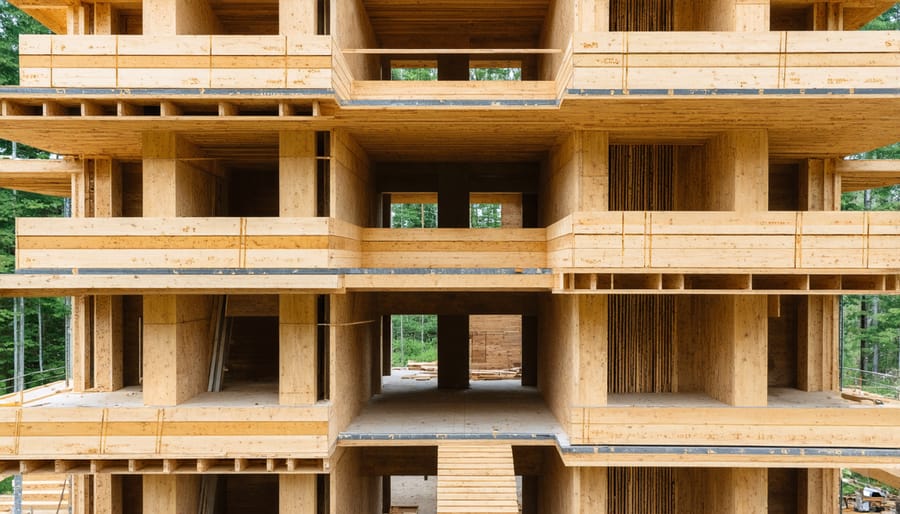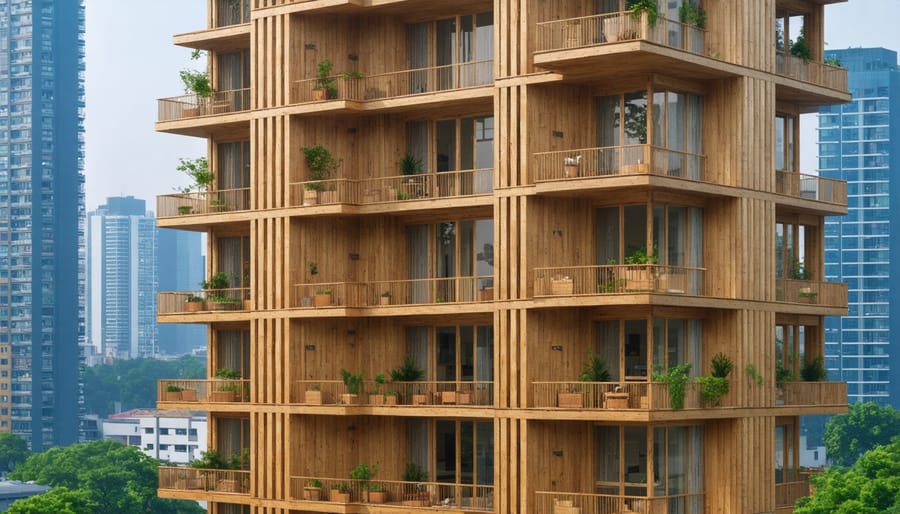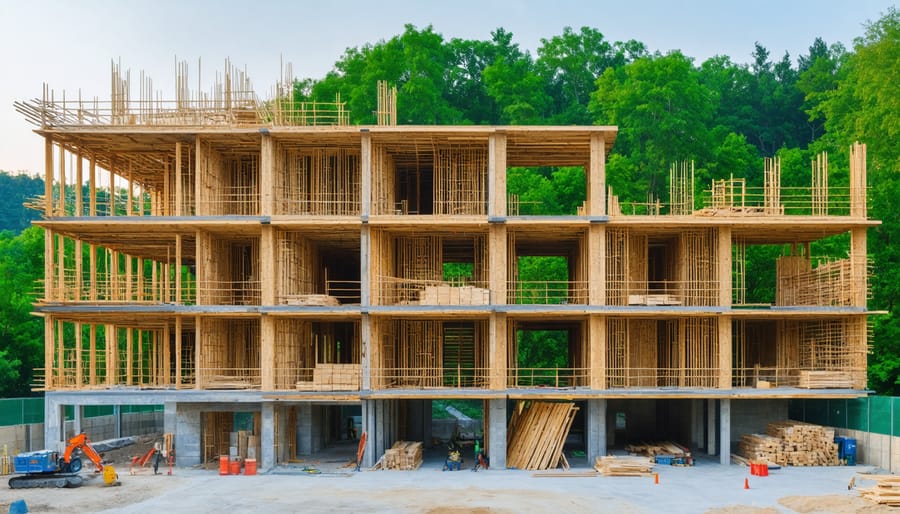As the construction industry grapples with mounting environmental challenges, sustainable biomaterials emerge as a transformative solution that merges ecological responsibility with engineering excellence. These innovative materials, derived from renewable biological sources, are revolutionizing how we approach building design and construction methodology.
Advanced biomaterials, from mycelium-based insulation to cross-laminated timber and algae-integrated facades, demonstrate remarkable performance characteristics while significantly reducing carbon footprints. Recent industry data indicates that buildings incorporating sustainable biomaterials achieve up to 45% reduction in embodied carbon compared to traditional construction materials, while maintaining or exceeding structural integrity requirements.
The convergence of biotechnology and construction engineering has created unprecedented opportunities for developing high-performance, environmentally responsible building solutions. Leading architectural firms worldwide are increasingly integrating bamboo composites, agricultural waste products, and engineered wood products into their designs, marking a decisive shift toward bio-based construction alternatives.
This evolution in material science not only addresses urgent sustainability demands but also opens new avenues for innovation in architectural design, structural engineering, and construction methodologies. As regulatory frameworks increasingly favor sustainable solutions, understanding and implementing biomaterial technologies becomes essential for construction professionals committed to future-ready building practices.
Revolutionary Bio-Based Building Materials Taking Center Stage
Cross-Laminated Timber (CLT) and Engineered Wood Products
Cross-laminated timber (CLT) represents a significant advancement in sustainable construction materials, combining structural performance with environmental benefits. This engineered wood product consists of multiple layers of timber boards stacked perpendicular to each other and bonded with structural adhesives, creating panels with exceptional strength-to-weight ratios and dimensional stability.
Through advanced manufacturing techniques, CLT panels achieve remarkable structural capabilities while maintaining the natural carbon-sequestering properties of wood. Recent testing has demonstrated that CLT structures can match or exceed the performance of traditional steel and concrete in many applications, particularly in mid-rise construction projects.
Key advantages of CLT include reduced construction time, lower carbon footprint, and superior thermal performance. Industry data shows that CLT buildings can be erected up to 30% faster than conventional structures, while offering enhanced acoustic properties and fire resistance. The material’s precision engineering allows for prefabrication, minimizing on-site waste and improving quality control.
Notable engineered wood innovations also include Glulam (glue-laminated timber) and Mass Timber products, which complement CLT in modern sustainable construction. These materials are increasingly specified in commercial projects, demonstrating their viability as alternatives to traditional building materials while meeting stringent building codes and performance requirements.

Mycelium-Based Materials
Mycelium-based materials represent a groundbreaking advancement in sustainable construction, utilizing the root structure of fungi to create robust, lightweight building components. These materials are cultivated by combining agricultural waste products with mycelium spores, which grow to form a dense network of fungal threads that bind the substrate together.
The resulting composite materials demonstrate remarkable properties, including fire resistance, excellent thermal insulation, and acoustic absorption capabilities. Testing has shown compression strengths comparable to some conventional insulation materials, with densities ranging from 60 to 300 kg/m³ depending on the cultivation process and substrate selection.
Industry applications currently focus on non-structural elements such as insulation panels, acoustic tiles, and decorative facades. Notable projects include Dell’s sustainable packaging solutions and architectural installations at MoMA PS1 in New York. The manufacturing process requires minimal energy input and produces zero waste, as the materials are fully biodegradable at end-of-life.
Recent developments have improved scalability through automated production methods and standardized growth conditions. Research indicates potential improvements in structural capacity through hybrid systems combining mycelium with traditional materials. While current costs remain higher than conventional alternatives, increasing production efficiency and market demand are expected to drive prices down.
Key advantages include carbon sequestration during growth, minimal environmental impact, and the ability to be grown in virtually any location with proper conditions. These factors position mycelium-based materials as a promising solution for reducing construction’s environmental footprint.

Performance Metrics That Matter
Structural Integrity and Durability
The structural integrity and durability of sustainable biomaterials have advanced significantly, meeting or exceeding the performance standards of traditional modern construction materials in numerous applications. Recent laboratory testing reveals that engineered bamboo composites demonstrate impressive compressive strength ratings of 11,000 psi, comparable to conventional concrete. Similarly, cross-laminated timber (CLT) exhibits exceptional dimensional stability with moisture content variations of less than 2% under controlled conditions.
Performance metrics from industry studies indicate that mycelium-based materials show remarkable durability, with accelerated aging tests demonstrating minimal degradation over simulated 50-year periods when properly treated. These materials maintain structural integrity while providing natural fire resistance properties, achieving Class B fire ratings without additional chemical treatments.
Engineered wood products, particularly those incorporating bio-based adhesives, have demonstrated superior load-bearing capabilities. Testing data shows that these materials can withstand cyclic loading for over 100,000 cycles without significant structural compromise, surpassing many traditional building materials in long-term performance stability.
The incorporation of natural fibers into bio-composite matrices has yielded impressive tensile strength values ranging from 290 to 510 MPa. These results, validated through extensive third-party testing, confirm their suitability for load-bearing applications in commercial construction. Furthermore, impact resistance testing reveals that certain bio-composite formulations exhibit up to 30% higher impact absorption capacity compared to conventional materials, enhancing their longevity in high-stress environments.
Environmental Impact Assessment
The environmental impact of sustainable biomaterials extends far beyond their immediate applications in construction. Lifecycle analysis (LCA) studies demonstrate that most bio-based materials exhibit significantly lower carbon footprints compared to traditional construction materials. For instance, hemp-based insulation materials typically generate 40% less CO2 emissions during production than mineral wool alternatives.
Biodegradability presents a crucial advantage in reducing end-of-life environmental impact. Many sustainable biomaterials naturally decompose within 6-24 months under proper conditions, leaving minimal ecological footprint. This characteristic particularly benefits temporary construction applications and reduces landfill burden.
Carbon sequestration capabilities further enhance the environmental profile of biomaterials. During growth, plants used for biomaterial production actively capture atmospheric CO2. Research indicates that hemp-based construction materials can sequester approximately 325kg of CO2 per cubic meter throughout their lifecycle.
Environmental assessments must consider resource consumption during production. Most biomaterials require significantly less water and energy input compared to conventional materials. For example, manufacturing mycelium-based insulation consumes 90% less energy than producing traditional foam insulation boards.
Transportation impacts also factor into environmental calculations. Local sourcing of biomaterials can substantially reduce transportation-related emissions. Studies show that utilizing regional agricultural waste for construction materials can decrease transportation emissions by up to 70% compared to traditional material supply chains.
However, comprehensive environmental assessment must account for potential drawbacks, including land use competition with food crops and the environmental impact of agricultural practices. Sustainable certification systems and responsible sourcing protocols help mitigate these concerns while ensuring optimal environmental performance throughout the material lifecycle.
Real-World Implementation Success Stories
Commercial Building Applications
Commercial buildings are increasingly incorporating sustainable biomaterials to achieve both environmental goals and enhanced occupant well-being. Leading architectural firms are utilizing mycelium-based insulation panels, which offer superior thermal properties while sequestering carbon. These innovative solutions, combined with recent structural performance innovations, are revolutionizing modern office construction.
Notable examples include the Edge Building in Amsterdam, which features bamboo-composite flooring systems and hemp-based wall panels throughout its 40,000-square-meter office space. The material selection has contributed to a 70% reduction in embodied carbon compared to traditional construction materials while maintaining superior acoustic properties and fire resistance ratings.
Retail spaces are adopting cross-laminated timber (CLT) for both structural and aesthetic purposes, with major retailers like Whole Foods implementing exposed CLT ceiling systems in their new locations. These applications demonstrate the versatility of biomaterials in meeting stringent commercial building codes while delivering sustainable performance metrics.
Recent innovations in bio-based finishing materials, such as algae-derived coatings and agricultural waste composites, are providing architects with expanded options for interior applications. These materials offer enhanced durability, low VOC emissions, and natural antimicrobial properties, making them particularly suitable for high-traffic commercial environments.

Residential Construction Innovations
Recent residential construction projects have demonstrated remarkable innovation in biomaterial applications, offering sustainable alternatives to traditional building materials. Cross-laminated timber (CLT) structures have gained significant traction, with notable projects like the 25-story Ascent Tower in Milwaukee showcasing the material’s structural capabilities and fire resistance properties.
Mycelium-based insulation has emerged as a groundbreaking solution, providing excellent thermal performance while being completely biodegradable. In Sweden, several pilot homes have successfully implemented mycelium panels, reporting a 40% reduction in heating costs compared to conventional insulation materials.
Hemp-lime composites (hempcrete) continue to prove their worth in residential construction, particularly in load-bearing walls and interior partitions. These materials offer superior moisture regulation and carbon sequestration properties, with recent studies indicating they can absorb up to 370 kg of CO2 per cubic meter during their lifetime.
Bamboo-engineered products have revolutionized flooring and decorative applications, while advanced bio-based adhesives derived from soy and lignin have replaced traditional petroleum-based options. These innovations extend to exterior applications, where bio-composite cladding materials demonstrate exceptional weathering resistance and durability.
Modern residential projects increasingly incorporate agricultural waste products, such as rice husk ash and bagasse fiber, into concrete mixtures and particle boards, creating circular economy solutions while maintaining structural integrity and performance standards.
Future-Proofing Construction with Biomaterials
The construction industry stands at the cusp of a biomaterial revolution, with emerging technologies and research pointing towards a future where sustainable materials become the norm rather than the exception. As innovative construction technologies continue to evolve, biomaterials are playing an increasingly crucial role in shaping tomorrow’s building practices.
Recent developments in mycelium-based materials show particular promise, with researchers successfully creating structural elements that match traditional building materials in strength while offering superior insulation properties. These living materials can be grown in predetermined shapes and sizes, potentially revolutionizing prefabrication processes.
Advanced biocomposites, combining natural fibers with bio-based resins, are emerging as viable alternatives to traditional petroleum-based materials. Industry experts project that by 2030, these materials could replace up to 30% of conventional construction materials in specific applications, particularly in non-load-bearing elements and interior finishes.
Biomimetic design principles are driving innovation in structural systems, with materials that can self-heal and adapt to environmental conditions. For instance, self-repairing concrete incorporating bacterial spores has moved from laboratory testing to real-world applications, demonstrating the potential for reducing maintenance costs and extending building lifespans.
The integration of smart biosensors within biomaterials represents another frontier, enabling real-time monitoring of structural health and environmental conditions. These developments are particularly relevant for ensuring long-term durability and performance of bio-based building components.
To ensure successful implementation, the industry is developing new standards and certification processes specifically for biomaterials. These frameworks will address concerns about durability, fire resistance, and long-term performance, making it easier for architects and engineers to specify these materials with confidence.
Investment in research and development continues to grow, with major construction companies establishing dedicated biomaterial innovation centers. This commitment to advancement suggests that biomaterials will become increasingly cost-competitive and technically sophisticated, ready to meet the demands of future construction projects.
The integration of sustainable biomaterials in construction represents a critical shift toward environmentally responsible building practices while maintaining high performance standards. Throughout this exploration, we’ve seen how materials like cross-laminated timber, mycelium-based composites, and agricultural waste products offer viable alternatives to traditional construction materials.
For construction professionals looking to implement these solutions, several key considerations emerge. First, carefully evaluate the specific performance requirements of your project against the capabilities of available biomaterials. Consider factors such as load-bearing capacity, durability, and local climate conditions. Second, ensure compliance with local building codes and regulations, as standards for biomaterials continue to evolve.
Cost considerations should account for the full lifecycle of the material, including maintenance requirements and end-of-life disposal or recycling options. While initial costs may sometimes be higher, the long-term benefits often justify the investment through reduced environmental impact and potential energy savings.
Moving forward, stay informed about emerging technologies and new biomaterial developments. Establish relationships with reliable suppliers and manufacturers who can provide consistent quality and necessary documentation. Consider starting with smaller-scale applications to gain experience and build confidence in these materials.
The future of sustainable construction lies in the balanced integration of biomaterials with traditional building methods. By making informed decisions today, construction professionals can lead the industry toward a more sustainable future while meeting the demanding requirements of modern construction projects.

